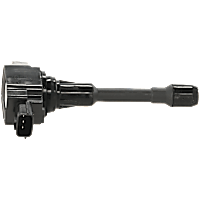Pop the hood on an older vehicle and you’ll find a cumbersome distributor ignition system with spark plug wires snaking all over the place.
Thankfully, these days, nearly all cars have a distributor-less ignition system. The design does away with the inefficient parts found in older applications by using multiple ignition coils. Each cylinder (or a pair of cylinders) gets a dedicated coil.
Watch this video to understand how ignition coil works:
Generally, modern ignition coils are robust and trouble-free. But like anything else, ignition coils can eventually fail, and when that happens, the engine will begin to misfire. And as a result, the check engine light will turn on.
The problem is, there are many issues besides a bad coil that can cause a misfire. That’s why it’s helpful to know how to test an ignition coil and determine whether it’s faulty.
How to Test an Ignition Coil on a Modern Car: 6 Different Methods
Professionals often use the term coil pack to describe any type of modern ignition coil. But, by definition, a coil pack is a group of ignition coils combined together in a single molded block. With this design, each cylinder gets its own ignition tower but shares its coil with a companion cylinder.

This is different than the more commonly used coil-on-plug (COP) ignition system. In a COP system, each cylinder gets its own ignition coil that sits on top of the spark plug.

For the sake of convenience, however, we’ll refer to both designs as ignition coils in this article.
Note: We will not be covering distributor-style ignition systems that use just one coil.
Although testing ignition coils can be tricky, it’s doable if you have the tools and knowledge. Here are six different methods that will help you get the job done.
Perform a Visual Inspection
In some cases, you’ll be able to spot a bad ignition coil with a simple visual inspection. Issues, such as cracks, burn marks, and carbon tracking, point to a faulty coil.
Swap the Suspect Ignition Coil to Another Cylinder
If your car has individual ignition coils (or packs that combine just two coils), you can swap the suspect ignition coil to another cylinder to see if the misfire follows.
It’s best to use a scan tool or code reader when performing this procedure.
The following video demonstrates this test method:
But wait—what if you don’t have a scan tool or code reader? In many cases, you can perform a power balance test to cancel out each cylinder. You’ll want to listen for a drop in RPMs as each cylinder is cut out. A cylinder that demonstrates little to no change in RPMs is problematic and not contributing fully.
Here’s an excellent video describing a power balance test:
Keep in mind: A drop in RPMs on a specific cylinder can be caused by other issues (i.e., fuel delivery or engine mechanical problems) besides a bad coil. To verify whether the coil is to blame, you’ll want to swap the coil to another cylinder and repeat the power balance test. If the loss of contribution moves with the coil, the ignition coil is faulty.
Caution: Never perform a power balance test by disconnecting the spark plug wires. Damage to the vehicle and severe injury may result.
Use a Spark Tester
You can also test an ignition coil with a spark tester. The tool is installed inline with the ignition coil to determine if the coil is producing a spark.
Note: If all of the ignition coils aren’t delivering spark, the issue is likely with the control side (primary side) of the ignition system, rather than a single ignition coil. An absence of spark from just ONE ignition coil points to a bad coil.
Not all spark testers work with all types of ignition systems, so be sure to select the right tool for your application. It’s also a good idea to get a quality, adjustable spark tester. Inexpensive non-adjustable testers can be misleading because sometimes they still illuminate with a weak spark.
The steps for using a spark tester will vary, depending on the tool you’re using and the type of ignition system your car has. But the following video will give you an idea of what’s involved:
You may hear some people recommend removing the spark plug and grounding it instead of using a spark tester. The issue is, it takes less voltage to fire a spark plug that has been removed from the engine than one that’s still installed.
So, although you may have spark, it may not be adequate to jump the plug gap with the engine running.
A quality spark tester, on the other hand, requires tens of thousands of volts to fire. Because of this, the tool provides an accurate measurement of whether there’s enough spark to jump the plug gap.
Plus, using a spark tester is safer than grounding a plug.
Use a Coil-on-Plug (COP) Probe
A coil-on-plug (COP) probe is a tool that uses a phenomenon called magnetic induction to give a clear indication of whether a COP coil is firing. Some COP probes simply flash a light to indicate the coil is working, while others display data on a screen.
Using a COP probe is easy. Simply follow the product instructions regarding set up, then place the paddle end of the tool over the coil. In the case of a flashing-style probe, the tool will illuminate if the coil is firing.
This video demonstrates the proper use of a COP probe:
Check the Resistance of the Ignition Coil
Measuring ignition coil resistance was once a popular test method. The procedure involves using a digital multimeter (set to ohms) to check the resistance of the primary and secondary windings inside the coil. Comparing the results to the manufacturer’s specifications is supposed to indicate whether the coil is good or bad.
But resistance testing has fallen out of favor because it isn’t always conclusive. Since you’re not monitoring the coil when it’s hot or under load, it’s possible for a bad coil to pass a resistance test. What’s more, fewer automakers are listing coil resistance specifications in their repair information.
Still, in some instances, the test can prove useful. You can learn how it works by watching the video below:
Monitor the Ignition Pattern with an Oscilloscope
Without a doubt, an oscilloscope is the best tool for diagnosing ignition system problems of any kind, including a bad coil.
An oscilloscope can be used to display a waveform pattern of the ignition system signal voltage as a function of time. The drawbacks are that scopes are usually expensive to purchase and many people find them difficult to use.
The video below demonstrates using a relatively inexpensive, single-channel scope to pinpoint a bad coil. Toward the end, the host also verifies the failure using a simple test for spark.
Here is another video showcasing a slightly different approach:
What Is a Coil Pack In an Engine?
A coil pack is a group of ignition coils that acts as a transformer. It takes low voltage from the battery and gives it a boost to bridge the gap in spark plugs, causing the fuel and air to ignite and create the spark needed to start a vehicle.
The coil pack’s location differs depending on the car. Typically, it is mounted on the engine near the distributor.
What to Do if Your Car Has a Bad Ignition Coil
If you find your car has a bad ignition coil, you’ll want to fix the problem right away. A faulty coil can damage other parts of your vehicle, such as the catalytic converter. The issue can also lead to a significant decline in engine performance, making your car difficult to drive.
The good news is, most ignition coils are relatively inexpensive and easy to replace. That means you (or your mechanic) can repair your car and have it back on the road in a short amount of time.
How to Get an Ignition Coil for Your Vehicle
First order of business: stop driving your car. Driving around with a faulty ignition coil can damage other parts of your vehicle that can be costly to fix. If you don’t want a bigger repair bill, you should replace your ignition coil as soon as possible. Luckily, getting a brand-new ignition coil is fast and easy with CarParts.com.
CarParts.com offers a wide selection of high-quality ignition coils sourced from the most trusted manufacturers in the industry. You can easily browse through available parts using our vehicle selector and search filters. If you’re itching to get back on the road, then you’ll be pleased to know that CarParts.com also offers fast shipping. Order by 12 p.m. ET, and you can expect your new ignition coil to arrive in as fast as two business days.
Don’t wait until your ignition coil damages other parts of your vehicle before replacing it. Check out our selection of high-quality ignition coils at CarParts.com and order yours today!
Products Mentioned in this Guide
Any information provided on this Website is for informational purposes only and is not intended to replace consultation with a professional mechanic. The accuracy and timeliness of the information may change from the time of publication.


 Ignition Coil
Ignition Coil
 Spark Plug
Spark Plug
 Spark Plug Wire
Spark Plug Wire

















